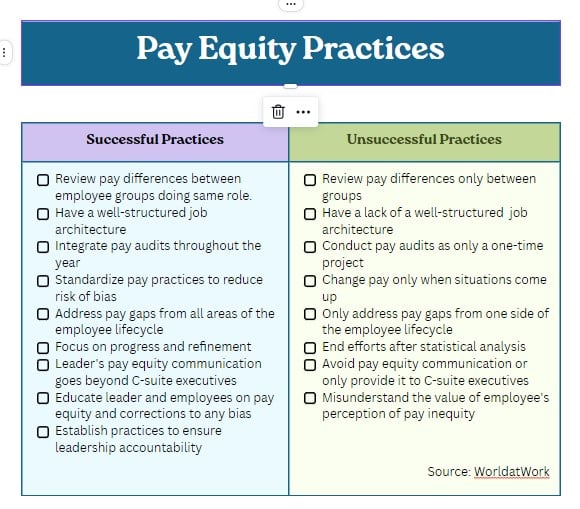Ever wonder what’s driving the pay equity strategies of other companies?
Well, Felicia Cummings and Nicole Corona, HR leaders with Health Care Services Corp., wanted to know and informally polled attendees at their WorldatWork conference session this week, Pay Equity: Taking on the Elephant in the Room.
A majority of attendees attributed their pay equity actions to pay transparency legislation, and, to a slightly lesser degree, their evolving HR strategy and compensation practices.
No matter what’s prompting the shift toward pay equity, for many HR leaders, it is adding a sizeable workload—from having to gather the data needed to do pay comparisons to developing training materials for managers to explain new pay approaches to their team members. Apart from new responsibilities, for many, this foray into pay equity is also fueling anxiety, as HR professionals are increasingly facing employee questions about salary—and, given the current labor market, HR needs to have answers ready, experts say.
The pain is real
For some HR leaders, employee confrontations about pay may even become public.
Some employees are turning to social media like TikTok, for example, to vent their anger over a perceived lack of pay equity as they begin to learn the going rate for their position at their company and at other organizations, says Cummings, executive director of compensation, at Health Care Services Corp., which sells health rated products and services.
“This is creating anxiety with leaders and executives,” Cummings says. “And it’s creating employee churn.”
To manage in this new environment where transparency is becoming expected, some HR leaders are even going as far as creating cheat sheets for managers on how they can respond to employees when asked for salary or pay range information. In addition to facing employees’ questions, HR leaders may also have to contend with government agencies, investors and others who may call for the company to do a pay-equity audit.
At the WorldatWork session, one compensation executive from Belgium noted fear is gripping her compensation colleagues in Asia. Culturally, those employees are more reserved and private, so the ability to learn colleagues’ salary range can create an uncomfortable situation; however, given the EU’s new pay transparency law, her company is moving toward transparency across its global operations.
Related: Pay equity: Who should be in charge?
Adopting pay equity best practices
To help ease these tensions and prepare recruiters to talk about pay equity from the start of the candidate experience, HCSC is increasing the frequency of interactions between its compensation and talent acquisition teams.
“Compensation and the TA people generally don’t work well together,” Cummings says, noting the potential competing interests that these two groups usually have.
However, Corona noted that HCSC’s approach is different.
“We like to hold quarterly meetings to talk about what each other needs and also tools TA can use,” Corona says.
Communication is central to a WorldatWork chart on pay equity best practices that Cummings and Corona shared, which also emphasizes a data-driven approach that is mindful of issues like bias.
 To create the most accurate pay equity matrix and have a solid foundation for the pay equity strategy, Cummings stressed HR leaders should also develop a strong relationship with the compliance department to help label jobs appropriately.
To create the most accurate pay equity matrix and have a solid foundation for the pay equity strategy, Cummings stressed HR leaders should also develop a strong relationship with the compliance department to help label jobs appropriately.
“The stronger the data, the better the analysis,” she says.

